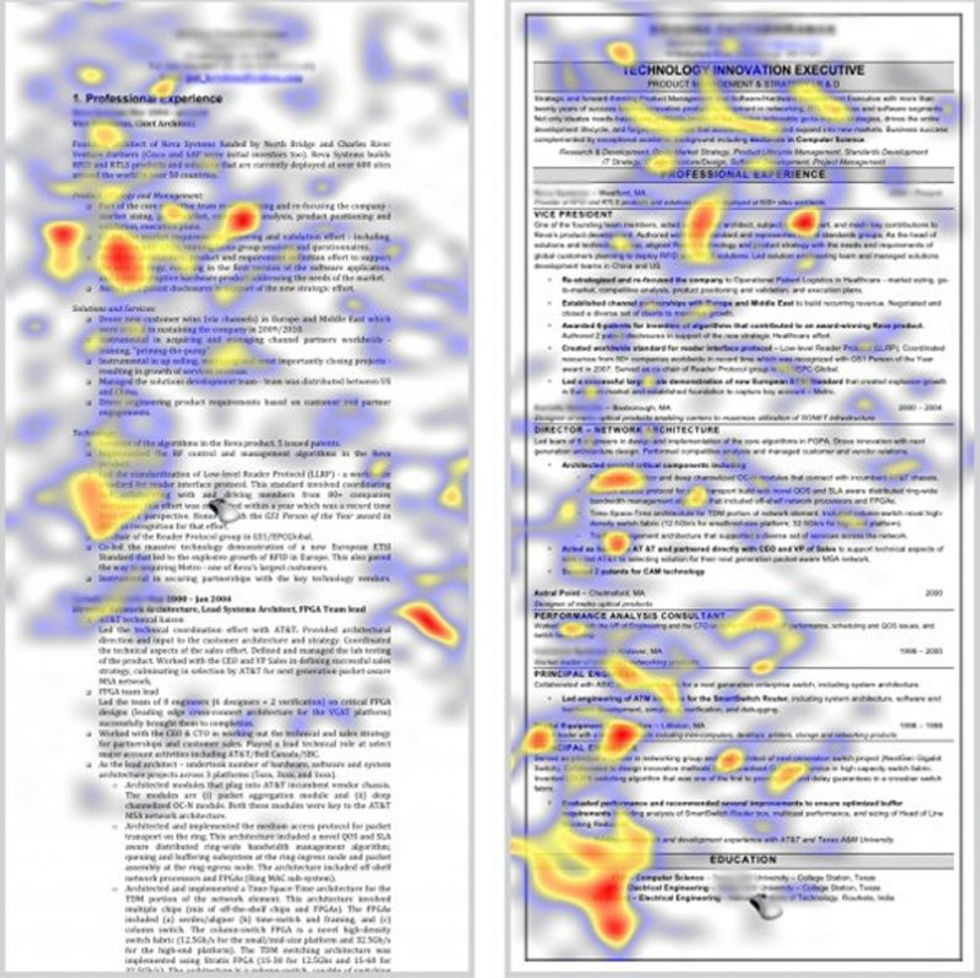
Did you know that you only have 5-6 seconds to capture the attention of recruiters and hiring executives in your resume? That’s how long they take to review resumes on average, and it’s not much time at all to interest them in your candidacy.
Related: 3 Resume Mistakes You’re Making And How To Correct Them Now
Research conducted on how recruiters read resumes and where their eyes linger can help you to structure your resume more efficiently while boosting the likelihood yours will get the thorough review it deserves. First, take a look at the heat maps created in research The Ladders used in a recent study to reveal which resume elements recruiters pay attention to the most.

1. Title
A title gives you resume focus and adds keywords. If you’re using your resume for networking purposes, use a title that showcases your job search goals. If you’re using your resume to apply for a specific position, use that role’s title as your resume’s focus. Either way, this title will add vital keywords to your resume while clarifying your career goals in seconds.- A networking title can be a bit broader than that of a specific role. For example, if you’re looking for a job in supply chain management, specific titles might include Director of Purchasing or Procurement Manager. A slightly more general networking title might include Senior Supply Chain Manager or Supply Chain Executive. Note how the networking title is broad enough to include multiple specific titles without being so broad it becomes generic.
- Consider adding a range of titles, industry interests, or a tagline to further set your candidacy apart from others.
- Read about seven title and tagline strategies that can propel your resume from blah to bold.
2. Brief, impactful summary
Like most credentialed resume writers, I continue to see “homemade” resumes with no summary. Omitting a summary from your resume is like walking into an interview and refusing to answer the general question, “Tell me about yourself.” Your summary offers your readers a big picture perspective of your career brand and candidacy and, as such, should highlight your strongest brand attributes.- An effective summary only needs to be 3-4 sentences in length. This is one area where more is definitely not better. Briefly summarize your range of experience, high-level achievements, and key brand attributes.
- Think specific, not general. Most “homemade” summaries are exceedingly generic – yours should be specific enough to set you apart from other candidates applying for the same kinds of roles.
3. Short keyword list
Select your top 6-12 keywords and list them in an easy-to-read fashion after your summary. Resist the temptation to make your list longer. Rather, make it more specific with industry-focused keywords rather than generic terms.- Weave these same keywords and related terms throughout the body of your resume, as well, paying particular attention to including them in position overview statements and achievement bullets.
4. Well-structured resume
The resume on the right in the photo above has an effective structure using lean sentences and short bullets. Notice that paragraphs are five lines or shorter and achievement bullets are two lines or shorter.- This meshes well with research done on well adults read and retain written information which demonstrates that they lose interest and the ability to retain details when reading lists or lines of text longer than six.
- The resume on the left burdens the reader with way too much information and too many levels of detail. Never gives your readers so much information in a resume (or LinkedIn profile) that they can make a decision on your candidacy without speaking to you.
5. Position overview statements
Another key quality of the resume on the right is that it separates position descriptions from achievements. This enables the latter to stand out more.- Position descriptions should be brief and big picture-oriented rather than laundry lists of responsibilities. Include relevant, recruiter-driven details such as the scope of your authority, the size of the team you managed, and the size of your budget or P&L. Don’t overlook important background information.
- Keep your position descriptions to 3-4 lines maximum to optimize readability.
6. Lean, quantified achievements
Every excellent resume needs a strong selection of quantified achievements. I recommend listing 4-6 for your current or most recent role with a decreasing amount as your work history goes back in time. Limit achievements to two lines of text. Start sentences with action verbs, use lean language, and consider leading with your most impressive result. Eliminate unnecessary words and jargon.- Achievements should be impactful and hone in on the most important facets of your accomplishments.
- Include the results, outcomes, or impacts of your actions wherever possible.
- Quantify those results, outcomes, and impacts as much as possible.
7. Clear-cut credentials
There’s no need to “stuff” your education or credentials section with details. Include your relevant degrees, certifications, licenses, coursework, and affiliations without going overboard. Notice how short and to-the-point the education section is in the right-hand resume.- If your credentials are particularly relevant or impressive, consider showcasing them in your summary rather than in an education section.
Related Posts
Is Your Resume Summary Boring Employers? 3 Steps To A Killer Resume 4 Rules For Every Resume

 Bigstock
Bigstock Bigstock
Bigstock Bigstock
Bigstock


